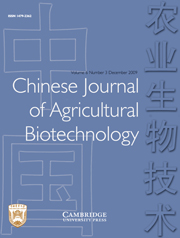Article contents
Genetic structure analyses of different populations of grass carp (Ctenopharyngodon idella) using the TRAP technique
Published online by Cambridge University Press: 15 June 2007
Abstract
Target region amplified polymorphism (TRAP) was used to compare genetic structures among three populations of grass carp (Ctenopharyngodon idella) – one wild and two cultured populations. Seven out of 15 primer combinations produced good amplification patterns and provided 103 amplified loci from the three populations. Numbers of polymorphic loci in the wild population were higher, indicating a decrease in genetic polymorphism in the two cultured populations. Compared with the wild population, only 39.98% loci gene frequency remained unchanged in the cultured samples, showing a genetic structure change in cultured populations. The genetic distances between wild and cultured populations were 0.0421 and 0.0809. With primer combination Ga5-800-E5, we detected a region in the electrophoretic pattern in which the number of amplified loci apparently decreased in cultured populations. These results establish a good scientific basis for developing molecular markers that can help in distinguishing wild from cultured populations.
Information
- Type
- Research Article
- Information
- Copyright
- Copyright © China Agricultural University and Cambridge University Press 2007
Footnotes
First published in Journal of Agricultural Biotechnology 2006, 14(4): 517–521
References
- 1
- Cited by

